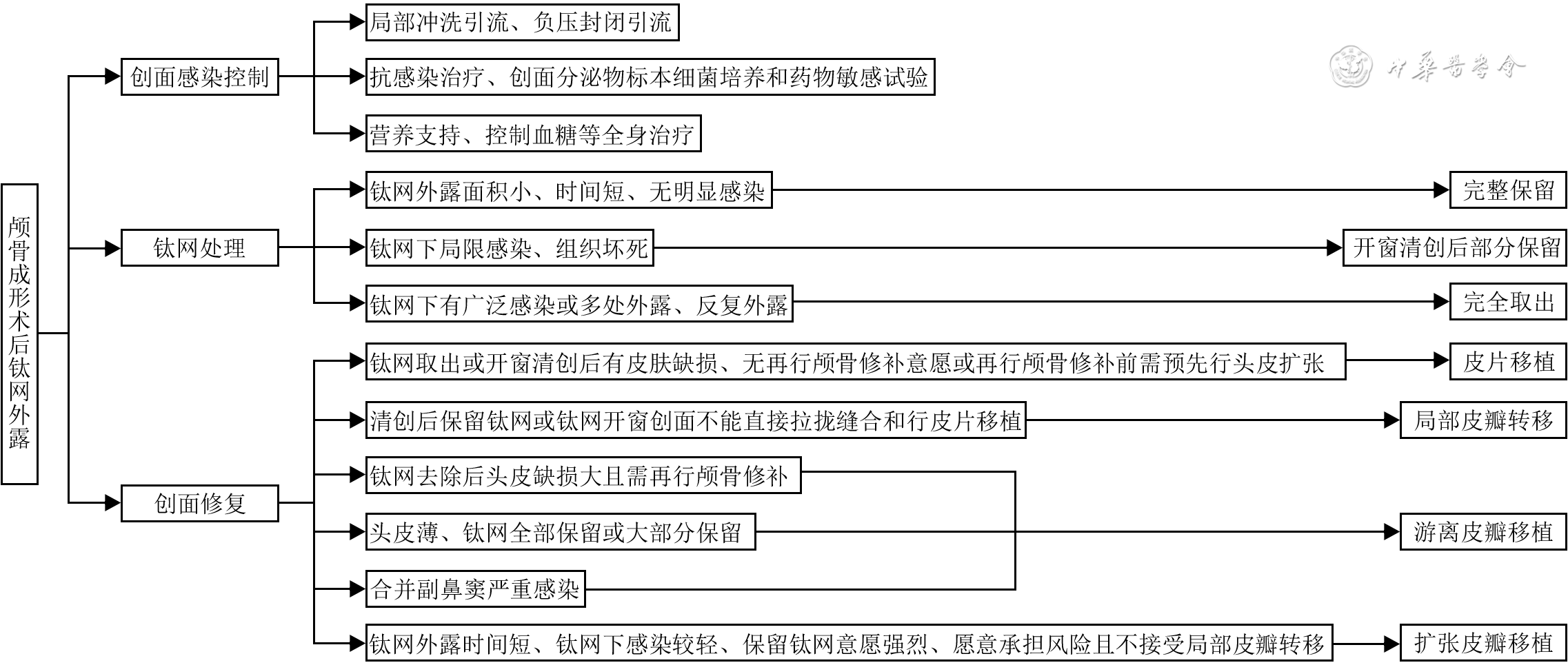National expert consensus on the prevention and wound repair of titanium mesh exposure after cranioplasty (2024 edition)
-
摘要: 颅骨成形术后发生的钛网外露是该术式最严重的并发症,尽管多年来临床上逐渐积累了一些针对钛网外露的诊治经验,但由于对其发生机制和并发感染的认识不足,治疗往往欠规范,难以达到令人满意的修复效果。为规范颅骨成形术后钛网外露创面的诊治,改善其治疗效果和患者生存质量,中国医师协会创面修复专业委员会组织专家讨论,基于国内外颅骨成形术后钛网外露创面的文献资料和诊疗现状,在颅骨成形术后钛网外露的发生机制、预防措施与诊治策略等方面达成了共识,以供相关临床医师参考。Abstract: Titanium mesh exposure after cranioplasty is the most serious complication of this procedure. Although some clinical experience has been gradually accumulated over the years in the diagnosis and treatment of titanium mesh exposure, the treatment is often not standardized and it is difficult to achieve satisfactory repair results due to insufficient understanding of its pathogenesis and concurrent infections. To normalize the diagnosis and treatment of titanium mesh exposed wounds after cranioplasty and improve the therapeutic effect and the quality of life of patients, the Wound Repair Professional Committee of Chinese Medical Doctor Association organized an expert discussion based on the literature and current diagnosis and treatment status of titanium mesh exposed wounds after cranioplasty at home and abroad, and reached a consensus on the pathogenesis, preventive measures, and diagnosis and treatment strategies of titanium mesh exposed wounds after cranioplasty to provide reference for relevant clinicians.
-
参考文献
(57) [1] SchallerB,GrafR,SanadaY,et al.Hemodynamic and metabolic effects of decompressive hemicraniectomy in normal brain. An experimental PET-study in cats[J].Brain Res,2003,982(1):31-37.DOI: 10.1016/s0006-8993(03)02900-7. [2] 中华神经外科学会神经创伤专业组,中华创伤学会神经损伤专业组,中国神经外科医师协会神经创伤专家委员会.创伤性颅骨缺损成形术中国专家共识[J]. 中华神经外科杂志,2016,32(8):767-770.DOI: 10.3760/cma.j.issn.1001-2346.2016.08.002. [3] YangJ,SunT,YuanY,et al.Evaluation of titanium mesh cranioplasty and polyetheretherketone cranioplasty: protocol for a multicentre, assessor-blinded, randomised controlled trial[J].BMJ Open,2019,9(12):e033997.DOI: 10.1136/bmjopen-2019-033997. [4] KungWM,LinFH,HsiaoSH,et al.New reconstructive technologies after decompressive craniectomy in traumatic brain injury: the role of three-dimensional titanium mesh[J].J Neurotrauma,2012,29(11):2030-2037.DOI: 10.1089/neu.2011.2220. [5] 柳大岗,郭庆雷,邹积典.颅骨修补术后反复钛网外露一例并文献复习[J].国际医药卫生导报,2016,22(9):1267-1269.DOI: 10.3760/cma.j.issn.1007-1245.2016.09.028. [6] ChengB,TianJ,PengY,et al.Iatrogenic wounds: a common but often overlooked problem[J/OL].Burns Trauma,2019,7:18[2024-02-03].https://pubmed.ncbi.nlm.nih.gov/31165077/.DOI: 10.1186/s41038-019-0155-2. [7] MukherjeeS,ThakurB,HaqI,et al.Complications of titanium cranioplasty--a retrospective analysis of 174 patients[J].Acta Neurochir (Wien),2014,156(5):989-998; discussion 998.DOI: 10.1007/s00701-014-2024-x. [8] MaqboolT,BinhammerA,BinhammerP,et al.Risk factors for titanium mesh implant exposure following cranioplasty[J].J Craniofac Surg,2018,29(5):1181-1186.DOI: 10.1097/SCS.0000000000004479. [9] YeapMC,TuPH,LiuZH,et al.Long-term complications of cranioplasty using stored autologous bone graft, three-dimensional polymethyl methacrylate, or titanium mesh after decompressive craniectomy: a single-center experience after 596 procedures[J].World Neurosurg,2019,128:e841-e850.DOI: 10.1016/j.wneu.2019.05.005. [10] 陈运江,韩志新.电脑成型三维钛网修补颅骨缺损的并发症和对策[J].中国医疗美容,2020,10(12):41-44.DOI: 10.19593/j.issn.2095-0721.2020.12.011. [11] 季玉陈,白亚辉,陈鑫璞,等.三维打印聚醚醚酮修补颅骨缺损的临床疗效[J].中华神经外科杂志,2021,37(8):837-839.DOI: 10.3760/cma.j.cn112050-20201230-00651. [12] 孙新林,王继辉,黄敏,等.聚醚醚酮与钛网在去骨瓣减压术后颅骨成形术中临床应用效果的单中心回顾性研究[J].中华神经医学杂志,2018,17(8):825-830.DOI: 10.3760/cma.j.issn.1671-8925.2018.08.012. [13] ThienA,KingNK,AngBT,et al.Comparison of polyetheretherketone and titanium cranioplasty after decompressive craniectomy[J].World Neurosurg,2015,83(2):176-180.DOI: 10.1016/j.wneu.2014.06.003. [14] ZhangQ,YuanY,LiX,et al.A large multicenter retrospective research on embedded cranioplasty and covered cranioplasty[J].World Neurosurg,2018,112:e645-e651.DOI: 10.1016/j.wneu.2018.01.114. [15] 丛文凯,解东成,刘一然,等.颅骨修补术中应用聚醚醚酮与钛网的临床效果比较[J].中华神经医学杂志,2022,21(4):365-372.DOI: 10.3760/cma.j.cn115354-20220123-00050. [16] YangJ,SunT,YuanY,et al.Evaluation of titanium cranioplasty and polyetheretherketone cranioplasty after decompressive craniectomy for traumatic brain injury: a prospective, multicenter, non-randomized controlled trial[J].Medicine (Baltimore),2020,99(30):e21251.DOI: 10.1097/MD.0000000000021251. [17] KwiecienGJ,RuedaS,CoutoRA,et al.Long-term outcomes of cranioplasty: titanium mesh is not a long-term solution in high-risk patients[J].Ann Plast Surg,2018,81(4):416-422.DOI: 10.1097/SAP.0000000000001559. [18] 张旭,杨理坤,朱洁,等.颅脑创伤行颅骨修补术后发生钛网外露的危险因素分析[J].中华神经外科杂志,2021,37(11):1154-1158.DOI: 10.3760/cma.j.cn112050-20210517-00239. [19] 张勇,孙胜禄,葛玉元,等.颅骨修补术后并发症及相关影响因素分析[J].交通医学,2018,32(5):444-447,450. [20] 谢才兰,邱炳辉,刘波,等.计算机三维成像颅骨修补前后颅腔容积变化与并发症的相关性[J].神经损伤与功能重建,2016,11(3):262-263.DOI: 10.16780/j.cnki.sjssgncj.2016.03.027. [21] YoshiokaN,TominagaS.Titanium mesh implant exposure due to pressure gradient fluctuation[J].World Neurosurg,2018,119:e734-e739.DOI: 10.1016/j.wneu.2018.07.255. [22] ZhangSL,LeeH,CaiEZ,et al.Dermointegration in the exposed titanium cranioplasty: a possible protective phenomenon[J].J Surg Case Rep,2021,2021(1):rjaa551.DOI: 10.1093/jscr/rjaa551. [23] KanD,HeX,LiuB,et al.Full-thickness skin regeneration beneath the exposed titanium mesh in cranioplasty: two cases report[J].Medicine (Baltimore),2023,102(33):e34821.DOI: 10.1097/MD.0000000000034821. [24] 朱剑萍,张金鹏,刘耀,等.正常成人多层螺旋CT灌注成像的头皮皮瓣脑血流动力学研究[J].中国临床医学影像杂志,2017,28(9):675-676.DOI: 10.3969/j.issn.1008-1062.2017.09.018. [25] YanoT,OkazakiM,TanakaK,et al.The flap sandwich technique for a safe and aesthetic skull base reconstruction[J].Ann Plast Surg,2016,76(2):193-197.DOI: 10.1097/SAP.0000000000000507. [26] OkadaY,NarushimaM,BandaCH,et al.Accelerated cranioplasty with perforator-preserved split flap sandwiched plate for treatment of infected cranial defects[J].Plast Reconstr Surg Glob Open,2022,10(4):e4234.DOI: 10.1097/GOX.0000000000004234. [27] WangW,VincentA,BahramiA,et al.Progressive scalp thinning over mesh cranioplasty and the role of lipotransfer[J].Laryngoscope,2020,130(8):1926-1931.DOI: 10.1002/lary.28463. [28] SahooNK,TomarK,ThakralA,et al.Complications of cranioplasty[J].J Craniofac Surg,2018,29(5):1344-1348.DOI: 10.1097/SCS.0000000000004478. [29] 闫焦,王继华,何永静,等.颅骨成形术术后钛网外露原因及防治进展[J].中国医疗美容,2019,9(1):102-107.DOI: 10.19593/j.issn.2095-0721.2019.01.026. [30] 徐中,刘惠祥,沈鸟松,等.颅骨修补术后皮瓣坏死与钛网外露原因分析及防治[J].中国临床神经外科杂志,2015,20(1):28-30.DOI: 10.13798/j.issn.1009-153X.2015.01.009. [31] 侯晓峰,张春阳,孙建营,等.颅骨修补手术时机的选择与手术技巧[J].中华神经外科杂志,2011,27(8):847-849.DOI: 10.3760/cma.j.issn.1001-2346.2011.08.033. [32] Dos Santos RubioEJ,BosEM,DammersR,et al.Two-stage cranioplasty: tissue expansion directly over the craniectomy defect prior to cranioplasty[J].Craniomaxillofac Trauma Reconstr,2016,9(4):355-360.DOI: 10.1055/s-0035-1549011. [33] 白晓东,柳晓杰,刘维维,等.扩张器预置皮瓣预防颅骨修补材料外露[J].中国美容整形外科杂志,2016,27(1):18-20.DOI: 10.3969/j.issn.1673-7040.2016.01.007. [34] 张猛,邵柏,颜庆华,等.颅骨修补术后钛网外露[J].临床神经外科杂志,2014,11(4):301-302,303.DOI: 10.3969/j.issn.1672-7770.2014.04.019. [35] 肖勇,付航,罗政云,等.负压封闭引流术应用于颅骨钛网外露的效果[J].中国临床神经外科杂志,2016,21(11):703-704.DOI: 10.13798/j.issn.1009-153X.2016.11.018. [36] 吴杉英,黄祖根,薛华栋,等.VSD联合组织瓣修复颅骨修补术后钛网外露[J].福建医科大学学报,2019,53(3):201-202. [37] 周业平.应用负压治疗伤口的临床实践及进展[J/CD].中华损伤与修复杂志(电子版),2009,4(1):10-12.DOI: 10.3969/j.issn.1673-9450.2009.01.002. [38] TakumiI,AkimotoM.One-stage reconstruction using a vascularized calvarial flap for intractable scalp ulcers in relation with cranial implants without removing the whole prosthesis[J].Neurosurg Rev,2009,32(3):363-368; discussion 368.DOI: 10.1007/s10143-009-0196-2. [39] 左毅,李宝明,周小卫,等.局部钛网切除术治疗颅骨缺损修补术后钛网外露10例临床分析[J].北华大学学报(自然科学版),2013,14(4):445-447.DOI: 10.11713/j.issn.1009-4822.2013.04.018. [40] ChenB,LiW,ChenD,et al.Partial titanium mesh explantation cured post-cranioplasty implant-associated scalp infection[J].J Clin Neurosci,2017,44:196-202.DOI: 10.1016/j.jocn.2017.06.060. [41] 何林,王瑞,朱婵,等.保留钛网清创后移植皮瓣/肌皮瓣修复颅骨成形术后钛网外露创面的临床效果[J].中华烧伤与创面修复杂志,2024,40(3):273-280.DOI: 10.3760/cma.j.cn501225-20231031-00163. [42] 侯宏义,王璐旭,谢松涛,等.颅骨修补术后钛网外露的整形外科修复[J].中华神经外科疾病研究杂志,2018,17(4):349-351. [43] ZhaoJ,SongG,ZongX,et al.Using the reversed temporal island flap to cover small forehead defects from titanium mesh exposure after cranial reconstruction[J].World Neurosurg,2018,112:e514-e519.DOI: 10.1016/j.wneu.2018.01.070. [44] 邵珠平,李文化,张波,等.皮肤减张缝合修复颅骨修补术后钛网外露的效果[J].中国临床神经外科杂志,2014,19(11):681-682.DOI: 10.13798/j.issn.1009-153X.2014.11.015. [45] 邵明辰,程鹏,崔彦魁.手术治疗颅骨修补术后钛网外露16例临床体会[J].中国医疗美容,2019,9(11):28-31.DOI: 10.19593/j.issn.2095-0721.2019.11.007. [46] 包志军,许济,王治国,等.皮瓣转移修复颅骨修补术后钛网外露[J].中国医师进修杂志,2017,40(3):244-246.DOI: 10.3760/cma.j.jssn.1673-4904.2017.03.015. [47] 梁日初,崔晟华,杨锋,等.颞浅筋膜转移联合游离植皮修补颅骨钛网外露16例疗效分析[J].中南医学科学杂志,2014,42(6):613-615.DOI: 10.3969/j.issn.2095-1116.2014.06.021. [48] TaliatG,KumarMK,ShivalingappaS.Salvage of a large exposed cranial implant on irradiated necrosed scalp using free latissimus dorsi and forehead flaps - a case report[J].Acta Chir Plast,2022,64(2):89-92.DOI: 10.48095/ccachp202289. [49] OthmanS,AzourySC,TecceMG,et al.Free flap reconstruction of complex oncologic scalp defects in the setting of mesh cranioplasty: risk factors and outcomes[J].J Craniofac Surg,2020,31(4):1107-1110.DOI: 10.1097/SCS.0000000000006421. [50] HanY,ChenY,HanY,et al.The use of free myocutaneous flap and implant reinsertion for staged cranial reconstruction in patients with titanium mesh exposure and large skull defects with soft tissue infection after cranioplasty: report of 19 cases[J].Microsurgery,2021,41(7):637-644.DOI: 10.1002/micr.30800. [51] 马富鑫,任盼,曹瑾,等.三维打印预成形钛网联合游离背阔肌肌瓣在头顶部鳞状细胞癌伴颅骨缺损治疗中的临床应用[J].中华烧伤与创面修复杂志,2022,38(4):341-346.DOI: 10.3760/cma.j.cn501120-20201221-00538. [52] VargoJD,PrzyleckiW,AndrewsBT.Surgical decision-making in microvascular reconstruction of composite scalp and skull defects[J].J Craniofac Surg,2020,31(7):1895-1899.DOI: 10.1097/SCS.0000000000006623. [53] 梁鹏飞,许喜生,张丕红,等.累及鼻窦的面部复杂缺损创面的修复方法及其临床效果[J].中华烧伤与创面修复杂志,2023,39(3):221-227.DOI: 10.3760/cma.j.cn501225-20221130-00520. [54] DongL,DongY,LiuC,et al.Latissimus dorsi-myocutaneous flap in the repair of titanium mesh exposure and scalp defect after cranioplasty[J].J Craniofac Surg,2020,31(2):351-354.DOI: 10.1097/SCS.0000000000006016. [55] 计鹏,胡大海,韩夫,等.扩张皮瓣修复钛网颅骨成形术后钛网外露创面的临床效果[J].中华烧伤杂志,2021,37(8):752-757.DOI: 10.3760/cma.j.cn501120-20200613-00306. [56] 刘代宏,冯剑,孙超峰,等.颅骨缺损修补术后钛网外露31例[J].中华烧伤杂志,2013,29(2):212-213.DOI: 10.3760/cma.j.issn.1009-2587.2013.02.031. [57] ZhaoYH,FengYH,DengHT,et al.Therapeutic strategies for retention of cranioplasty titanium mesh after mesh exposure[J].Acta Neurochir (Wien),2022,164(12):3101-3106.DOI: 10.1007/s00701-022-05365-w. -
Table 1. 2011版牛津大学循证医学中心证据等级标准
证据级别 具体描述 1级 基于随机对照试验或单人交叉临床试验的系统性文献回顾,对随机性研究的系统综述 2级 随机对照试验或效果显著的观察性研究 3级 非随机性、对照性队列研究或随访研究 4级 病例系列、病例对照研究或历史对照研究 5级 基于机制的推论 -
 张丕红钛网共识-网站版.mp4
张丕红钛网共识-网站版.mp4

-








 下载:
下载:




